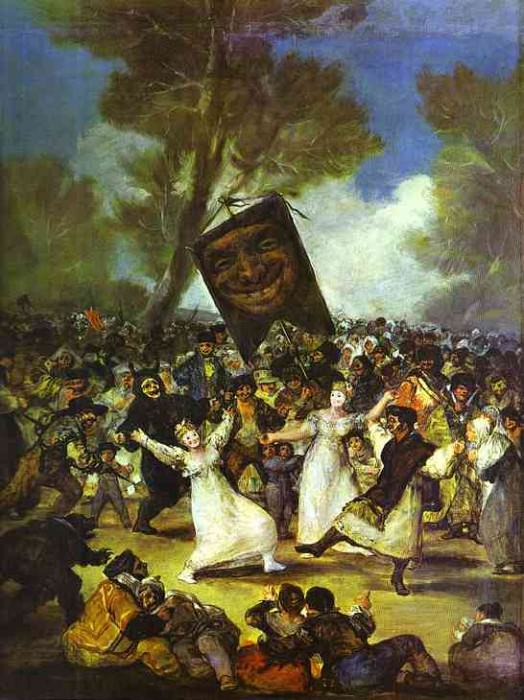The Burial of the Sardine Francisco Jose De Goya y Lucientes (1746-1828)
Francisco Jose De Goya y Lucientes – The Burial of the Sardine
Edit attribution
Download full size: 546×730 px (0,0 Mb)
Painter: Francisco Jose De Goya y Lucientes
The painting belongs to the brush of the Spanish artist Francisco Goya. The exact date of its creation is unknown. It is assumed that the painting was painted between 1812 and 1819. The central place on it is given to a frenzied crowd of people, carrying a banner with a smiling mask in the center. The title of the painting is related to a custom that originated in Spain back in the 18th century. One day before Ash Week, when all the inhabitants of Madrid gathered in the central square for a three-day carnival, the king of Spain ordered them to be served sardines.
Description of Francisco de Goya’s painting The Burial of the Sardine
The painting belongs to the brush of the Spanish artist Francisco Goya. The exact date of its creation is unknown. It is assumed that the painting was painted between 1812 and 1819.
The central place on it is given to a frenzied crowd of people, carrying a banner with a smiling mask in the center. The title of the painting is related to a custom that originated in Spain back in the 18th century.
One day before Ash Week, when all the inhabitants of Madrid gathered in the central square for a three-day carnival, the king of Spain ordered them to be served sardines. Unfortunately for the monarch’s reputation, the sardines were not fresh. This unfortunate circumstance, however, did not upset the townspeople in the slightest. By this time they had drunk so much wine and other spirits that they found nothing more amusing than to hold a sardine funeral.
The action seemed so amusing that they decided to repeat it the next year. This time they used sardines that had been spoiled beforehand. The sardine funeral pleased the Spaniards so much that it soon became enriched with new buffoonish customs and rituals.
It should be noted that, as ardent worshippers of the Catholic faith, the Spaniards did not see anything sacrilegious in such a ridiculous action, so in Goya’s time the tradition was not forgotten. Judging by how vividly painted the actors in the picture, the artist took a personal part in the "funeral procession". In the Spanish capital the farewell procession was led by "Uncle Chispas", his daughter Chusca and the young lover Juanillo.
It was they who led the crowd carrying a huge stuffed sardine head. The procession began in the main square and ended at the shore of Manzanares, in whose waters the ill-fated sardine found its rest. Today’s inhabitants of Spanish towns and villages also honor a similar custom.
Кому понравилось
Пожалуйста, подождите
На эту операцию может потребоваться несколько секунд.
Информация появится в новом окне,
если открытие новых окон не запрещено в настройках вашего браузера.
You need to login
Для работы с коллекциями – пожалуйста, войдите в аккаунт (open in new window).




















You cannot comment Why?
The central focus draws the eye towards two women in white dresses who appear to be dancing, surrounded by a cluster of participants. Below them, a group reclines on the ground, seemingly observing the spectacle with detached amusement or weary resignation. The figures are densely packed, creating a sense of overwhelming energy and disorder.
Above the crowd, suspended from a pole, is an oversized mask depicting a grotesque, smiling face. This element introduces a layer of unsettling ambiguity to the scene. While it could be interpreted as part of the festive decorations, its exaggerated features and somewhat sinister expression suggest a mocking or satirical undertone. The mask’s placement above the throng implies a sense of detached observation, perhaps representing an authority figure or societal institution looking down upon the proceedings with ironic amusement.
The landscape background is rendered in muted tones, with indistinct trees and foliage contributing to the dreamlike quality of the scene. This lack of detail directs attention towards the figures and their actions, emphasizing the performative nature of the event.
Subtly, the painting seems to explore themes of societal hypocrisy, fleeting joy, and the absurdity of ritualistic behavior. The contrast between the formal attire of some participants and the chaotic nature of the celebration hints at a critique of social conventions and power structures. The mask’s presence suggests that the merriment may be superficial or even forced, masking deeper anxieties or underlying tensions within the community. Ultimately, the work invites contemplation on the complex relationship between public display, individual identity, and the transient nature of human experience.